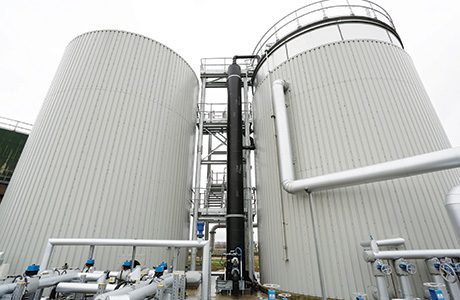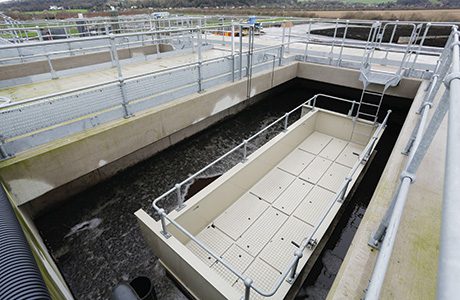AN innovative three-stage biological sewage treatment process, which cuts costs and improves efficiency, is approaching final commissioning at Nottingham’s Stoke Bardolph wastewater treatment works. The Severn Trent Water (STW) plant treats sewage from a 650,000 population as well as tricky trade waste from a local livestock rendering plant.
STW and design–build subcontractor NMCNomenca worked with Dutch company Paques BV to introduce three suitable and complementary technologies to the site in a first for the UK.
The combined use of Paques’ Phospaq, Biopaq UASBplus and Anammox processes has made it possible (1) to effectively remove phosphorus, (2) recover a phosphate fertiliser, (3) generate biogas and (4) deliver efficient ammonia removal at the site. It has also halved operational costs, made possible a 40% saving on capital expenditure and reduced the plant’s physical footprint by three-quarters.

The liquor dewatered from the sludge from the municipal sewage treatment is treated using two Phospaq reactors – the first in the UK – to remove the phosphorus, while the trade wastewater is run through a Biopaq Upflow Anaerobic Sludge Blanket (UASB) reactor to produce biogas. Both streams are then combined and sent to an Anammox reactor to remove ammonia.
A key advantage of introducing a Phospaq reactor at Stoke Bardolph is alleviation of struvite-related damage to equipment further along the train. The high concentration of phosphorus in dewatering liquors ordinarily leads to excessive struvite (magnesium-ammonium-phosphate) deposits in pipes, pumps and other equipment, which can cause significant operational and maintenance problems.
STW expects to make an annual saving of some £70,000 per year by reducing maintenance costs incurred by struvite damage to plant equipment. Capturing struvite as a resource will yield approximately 736t/year of phosphorus for conversion into fertiliser, providing STW with an additional revenue stream.

The Biopaq reactor for the trade waste converts organic compounds into mainly methane (CH4) biogas anaerobically. The gas is used for the combined heat and power (CHP) engines onsite and produces approximately 3MWh/day, contributing 7% to this energy-neutral site’s total gas output.
NMCNomenca’s automated approach to mechanical and electrical control of treatment at Stoke Bardolph has been a step-change for Paques in the way its systems are operated. Paques’ Simon
Kuitert says previous installations have been at more heavily manned sites, while in Nottingham the plant runs itself, flagging operational issues through an automated system.
NMCNomenca and Paques worked closely to deliver and optimise the operation and control system.
“It’s by far the most complex control system we’ve worked with,” says Simon Kuitert, Paques process engineer. “We’ve never automated Phospaq like this before. It’s been a learning process.”
Teresa Jeffcoat, NMCNomenca’s project manager says, “By working in close partnership with Paques and the client, we have achieved a system that demands only 50% of the air of a standard activated-sludge plant. Power consumption and energy costs have been slashed.
“Savings are also made when the new processes are compared with conventional nitrification and denitrification processes. Operational costs are reduced by over 50%, as are CO2 emissions.“
She added, “We are delighted with all we have achieved at Stoke Bardolph and are already seeing interest from other utilities in what can be achieved in terms of treatment efficiency and resource recovery.”






